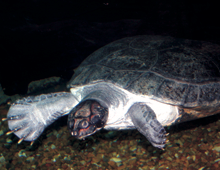Description: The Arrau side-necked turtle is usually olive green to brown, with orange, red or yellow markings on its head. The carapace is broad, domed and streamlined, which enables it to swim in moderate river currents. The long neck can be withdrawn into its shell horizontally, therefore leaving it partially exposed.
Size: The largest of the side-necks, the Arrau turtle may weigh more than 100 pounds (45 kg), with males smaller than females. The hatchlings, which are about two inches (five cm) long, emerge to the attentions of many predators.
Behavior: This species migrates considerable distances up or down rivers to localized, colonial nesting beaches. Two to three weeks prior to nesting, females bask on sand beaches in the morning and the late afternoon.
Diet: They are mainly herbivorous, eating aquatic vegetation and fruit, but occasionally they will eat carrion or slow-moving prey.
Senses: The outer ear gathers sound vibrations to make them louder. Turtles do not hear airborne sounds as loudly as humans, but they can sense and interpret vibrations in the environment. Hearing probably isn’t very important to a turtle though, because their senses of vision and smell are elevated. The brain center for hearing is quite small and underdeveloped.
Communication: Turtles are mostly solitary creatures; not much is known about how they
communicate with each other. They do seem to use some type of communication when it is time to mate. Some species will travel together to nesting grounds to mate. Some turtles will use a variety of methods to try and attract a mate, including head bobbing, biting the female’s legs, or use different leg movements while facing the females.
Reproduction: Sexual maturity is determined by size, not age – females at eight inches (20 cm), males at two feet (0.6 m). Females lay their eggs during the dry season when the water levels are the lowest. This occurs at different times of the year throughout their habitat. The females sun themselves on the beach for one to two weeks before laying their eggs. At night the eggs are laid on the highest part of the beach in a hole 23.6-31.5 inches (60-80 cm) deep. The incubation period is 45-65 days. Average clutch size ranges from 50-180 eggs and depends on the size of the female. Female turtles lay their eggs on the same beaches each year. Up to 500 turtles can be found laying their eggs on the same beach. On average, one male turtle hatches for every 30 female hatchlings. Newly hatched baby turtles often remain in the nest until the rains begin when they move down to the flooded river.
Habitat/range: They inhabit large rivers and tributaries, adjacent lagoons and forest ponds. They are found mainly in Caribbean drainages of Guyana & Venezuela, upper Amazon tributaries in Bolivia, Peru, Colombia, Venezuela and Brazil, and on the Islands of Trinidad and Tobago.
Status: Least Concern (LC) on the IUCN Red List; and is listed under Appendix II of CITES.



